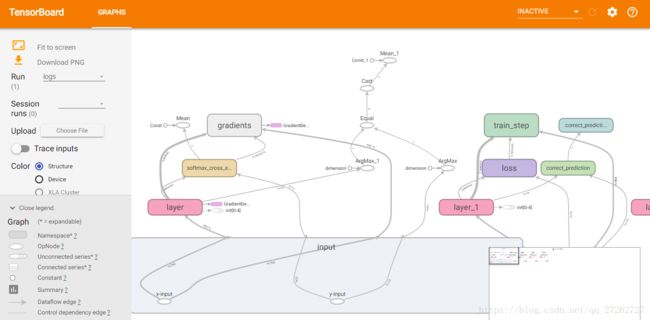Tensorflow的网络结构
本节主要讲一下Tensorflow的2可视化结构TensorBoard的使用。
以数据集简单分类为例:
import tensorflow as tf
from tensorflow.examples.tutorials.mnist import input_data
#载入数据集
mnist = input_data.read_data_sets("MNIST_data",one_hot=True)#加载数据集
#每个批次大小
batch_size = 100#训练模型一次性放一批次去训练
#计算一共有多少个批次
n_batch = mnist.train.num_examples // batch_size#训练数据数量/批次大小=一共有多少批次
#Tensorflow网络结构
#可视化结构:1、命名空间
with tf.name_scope('input'):#命名为input
#定义两个placeholder ,输入值
x = tf.placeholder(tf.float32,[None,784],name='x-input')#行784,列跟批次有关
y = tf.placeholder(tf.float32,[None,10],name='y-input')#数字0-9总共十个标签
with tf.name_scope('layer'):
#创建一个简单的神经网络输入层+输出层10个神经元
with tf.name_scope('wights'):
W = tf.Variable(tf.zeros([784,10]))#权值
with tf.name_scope('wx_plus_b'):
b = tf.Variable(tf.zeros([10])) #偏置值
with tf.name_scope('softmax'):
prediction = tf.nn.softmax(tf.matmul(x,W)+b)#预测值 使用softmax函数 x*W+b,转换成概率值,存在预测变量里面
#二次代价函数
# loss = tf.reduce_mean(tf.square(y-prediction))
with tf.name_scope('loss'):
loss = tf.reduce_mean(tf.nn.softmax_cross_entropy_with_logits(labels=y,logits=prediction))
#使用梯度下降
with tf.name_scope('train_step'):
train_step = tf.train.GradientDescentOptimizer(0.2).minimize(loss)#0.2的学习率,
#初始化变量
init = tf.global_variables_initializer()
#测试模型准确率==方法:结果存放在一个布尔型列表中
#求预测标签最大值在哪个位置,得到标签预测值跟真实值进行对比判断是否一样
with tf.name_scope('accuracy'):
with tf.name_scope('correct_prediction'):
correct_prediction = tf.equal(tf.arg_max(y,1),tf.arg_max(prediction,1))#argmax返回一维张量中最大值所在的位置
#求准确率
with tf.name_scope('accuracy'):
accuracy = tf.reduce_mean(tf.cast(correct_prediction,tf.float32))#对比的结果讲布尔型转换成float型,最后求平均值
with tf.Session() as sess:
sess.run(init)
#这里必须新建一个目录生成路径存放图结构的文件
writer = tf.summary.FileWriter('logs/',sess.graph)#在当前路径存放图结构for epoch in range(1):#迭代21个周期,把所有图片训练21次
for batch in range(n_batch):#n_batch一共定义的批次,把每一批次100张图片训练一次
batch_xs,batch_ys = mnist.train.next_batch(batch_size)#获得一百张图片,标签保存在这里面
sess.run(train_step,feed_dict={x:batch_xs,y:batch_ys})
acc = sess.run(accuracy,feed_dict={x:mnist.test.images,y:mnist.test.labels})
print("Iter" + str(epoch) + ",Testing Accuracy " + str(acc))
编译,运行完之后会在相对路径上创建一个'logs/'的文件夹,并在文件夹里面生成一个文件。
然后到控制命令行里面输入 tensorboard --logdir=你刚刚生成的文件夹路径(我的是这个C:\Users\Administrator\Tensorflow\5_week)
复制地址 http://PC-20170829CHLL:6006,到浏览器中打开,如下图所示:
注意:再控制命令行上输入命令的时候我遇到了两个问题
1、安装的pip版本问题
2、版本不兼容问题
后来百度解决了,如果又遇到同样问题的可以私信我。

